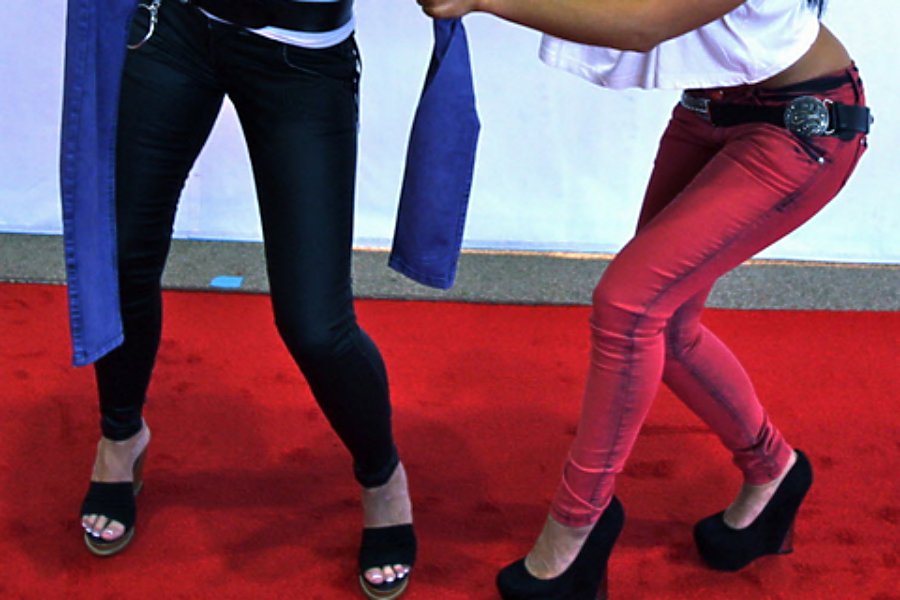Yoga pants too distracting for boys? A N.D. school cracks down on girls
Loading...
A North Dakota high school assembly on the school dress code – stipulating that yoga pants and skinny jeans must be appropriately
covered – was expected to last five minutes.
But last Friday the 220 girls stayed in the Devils Lake High School gymnasium for more than half an hour. There, they watched two short video clips from “Pretty Woman” (1990). In one, star Julia Roberts, who plays a prostitute in the R-rated movie, is dressed scantily. In the other, she was dressed to the nines.
“The image you project is so important,” Devils Lake principal Ryan Hanson says in an interview. “It matters so much to you as a woman. In our eyes, we’re trying to protect our kids, and sometimes they don’t see it that way.”
Indeed. These North Dakota students, parents, and teachers have leapt into a broader national dialogue about gender bias in school dress codes, body image, and societal standards and perceptions.
Friday's girls-only assembly was called after the Devils Lake assistant principal counted more than 30 girls in violation of the dress code, which stipulates that yoga pants, leggings and/or tight jeans must be appropriately covered by other clothing. Students were wearing yoga pants “stretched so thin that they become see through,” Mr. Hanson says. “Things aren’t left to the imagination, I guess.”
At the assembly, Hanson explains, a few students spoke out against what they said was an unfair policy, which the school’s assistant principal told a local TV station aims to keep boys focused on their academics. But Hanson notes that some girls also took offense to the video.
“A student said something to the effect of, ‘You’re calling us prostitutes,’” he recalls. “That was not the intent — it was an unfortunate choice, because yes, she plays a prostitute in the movie, but that wasn’t what was trying to be stressed.”
Dress code disputes between high school students and administrators are nothing new, says Jo Paoletti, an associate American studies professor at the University of Maryland, who studies American children’s clothing. She calls the conflict a “clash of cultural meanings.”
Walkouts protesting dress codes have sprouted up around the US. this fall, The Guardian reported, as has the hashtag #iammorethanadistraction, which references the argument that boys cannot pay attention in class when girls wear tight outfits.
Last March, middle school girls protested a ban on leggings and yoga pants in Evanston, Ill., the Evanston Review reported. Hundreds of students signed a petition, and several marched — one carrying a poster that asked “are my pants lowering your test scores?”
The Associated Press reported last month that 200 detentions (90 percent girls) followed a Staten Island dress code change that bans skimpy clothing. Fifteen Tottenville High School staff members look for violations in the approximately 4,200-person student body, the New York Post reported.
Conflict arises, professor Paoletti says, when adults ascribe meaning to clothing that students do not share. She connects the current battles over yoga pants and leggings to men growing their hair long in the 1960s.
In this case, she says, students and adults are “not quite on the same wavelength.” “The more adults say, ‘because I said so, you’ll understand when you’re older,’ the more there’s a rift between the people who are supposed to be abiding by the rules and the people who make them,” she says.
At Devils Lake High School, when individual students violate the dress code, officials first ask them to change their outfits, Hanson says. If students don’t have anything to change into, the school will offer them spare clothing. And if that doesn’t work, he says, they must stay in the office until a parent brings them new clothing — for each class period missed, they’ll have to sit a one-hour detention.
The assembly’s message, Hanson says, was supposed to focus more on how people perceive one another differently depending on how they dress. Noting the largely critical media spotlight on the dress code ban, he says that the school “didn’t handle the situation 100-percent perfectly” and that he
plans to apologize to the female students in a future assembly.







